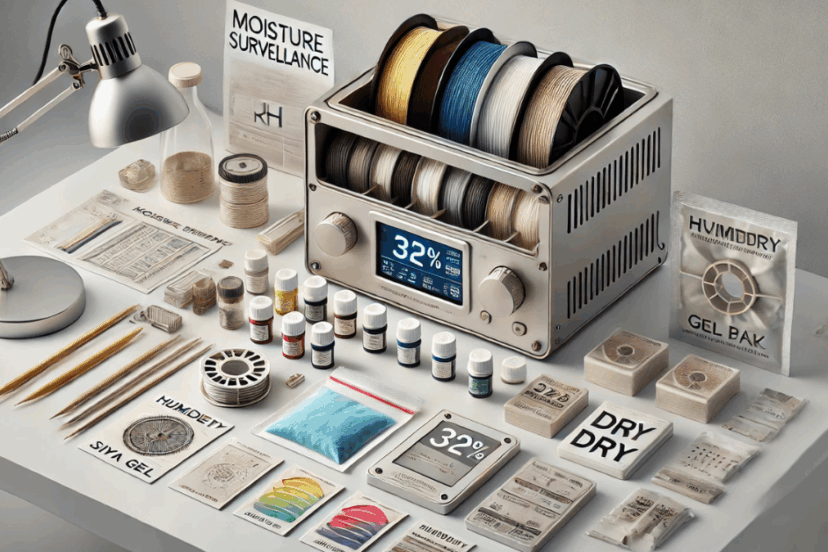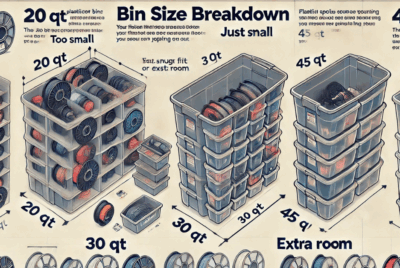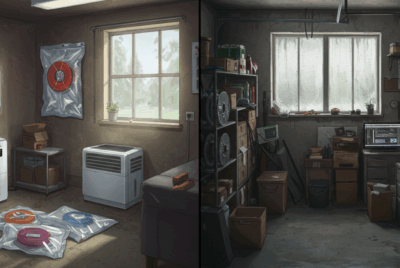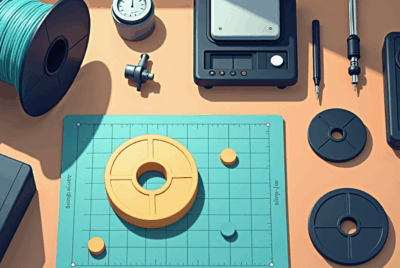What Tools Help Track Filament Humidity and Dryness Levels?
1. Humidity Is the Silent Print Killer
Everything’s dialed in—temps, speeds, retraction, slicer magic.
But suddenly, your print fails. Stringing. Bubbling. Weak walls.
If you haven’t been tracking filament humidity, you’re fighting an invisible enemy.
Let’s talk about the tools that help you monitor moisture before it ruins your print.
2. Why Monitoring Humidity Actually Matters
Filament is hygroscopic—it pulls water out of the air.
Even with decent storage, some humidity sneaks in over time.
If you’re not watching moisture levels:
- You won’t know when filament needs re-drying
- You’ll risk poor print quality
- You might damage your hot end or nozzle
Humidity tracking = peace of mind + consistent results.
3. What Happens If You Skip Tracking Moisture
Without tracking tools:
- Silica gel dries up silently
- Bins get opened and exposed without notice
- Vacuum seals weaken over time
- You won’t catch moisture until your print fails
Don’t wait for bubbling prints to know your filament’s wet. Catch it before it happens.
4. Basic Tool #1: Color-Changing Silica Gel
✅ Use: In vacuum bags or bins
💡 Why it works: Changes color based on moisture saturation
🎯 Best for: Passive moisture detection
Common color changes:
| Dry | Saturated |
|---|---|
| Orange → Green | |
| Blue → Pink | |
| White → Transparent |
Pro tip: Bake at 250°F (120°C) for 1–2 hours to refresh.
5. Basic Tool #2: Humidity Indicator Cards
✅ Use: Toss one inside each bin or bag
💡 Why it works: Shows %RH with visual dots
🎯 Best for: Quick humidity checks
Typical cards show levels like:
- 10%
- 20%
- 30%
- 40%
If you see purple at 30% or higher → dry your filament.
They’re cheap, reusable, and reliable.
6. Intermediate Tool: Digital Hygrometers
✅ Use: Inside dry boxes or filament bins
💡 Why it works: Gives you an exact RH reading
🎯 Best for: Day-to-day monitoring
Top brands:
- ThermoPro TP49
- Govee Mini Hygrometer
- Inkbird ITH-10
Look for:
- High accuracy
- Compact size
- Battery-powered display
- Optional temp + RH combo
7. Advanced Tool: Bluetooth Humidity Sensors
✅ Use: For serious storage tracking
💡 Why it works: Sends data to your phone
🎯 Best for: Monitoring multiple bins at once
Best options:
- Govee Smart Sensors
- SensorPush HT1 or HT.w
- Inkbird IBS-TH1
Why they’re awesome:
- Track multiple bins or rooms
- View RH and temp over time
- Get alerts when humidity spikes
Perfect if you’re managing lots of spools or storing in a garage/basement.
8. Smart Storage Boxes with Built-In Monitoring
Some dry boxes come with integrated humidity monitoring:
- SUNLU S2
- PrintDry Pro
- eSun eBox
These display real-time RH levels inside the box and often:
- Keep filament warm/dry during prints
- Alert you when moisture creeps in
- Let you print without re-exposing filament
Smart choice for pros or active makers.
9. Environmental Monitors for Your Print Room
Why monitor just the filament?
Track your whole room!
✅ Tools like:
- ThermoPro TP67A (with remote sensors)
- AcuRite Home Monitor
- Inkbird IBS-M1 Smart Gateway
These let you:
- Check ambient humidity across zones
- Prevent “invisible” exposure
- Control HVAC or dehumidifiers accordingly
Best for garages, basements, or print farms.
10. DIY vs. Commercial Monitoring Tools
| Tool Type | DIY Friendly? | Accuracy | Cost |
|---|---|---|---|
| Silica Gel | ✅ Very | Medium | Low |
| RH Cards | ✅ Yes | Medium | Very Low |
| Digital Hygrometers | ✅ Yes | High | Moderate |
| Bluetooth Trackers | ❌ Not DIY | Very High | Moderate–High |
| Smart Dry Boxes | ❌ No | High | Mid–High |
| Room Monitors | ✅ Yes | High | Varies |
Start basic. Upgrade as your needs grow.
11. When to Use Each Type of Tool
- Storing in bins? → Hygrometer or card + silica
- Vacuum bagged? → Silica + RH card inside
- Dry box active? → Built-in monitor works fine
- Monitoring a large space? → Use a room sensor
- Managing multiple spools? → Use app-connected trackers
No need to buy everything—just get the right tool for your setup.
12. How to Know When It’s Time to Dry Again
If your RH:
- Goes above 40% for PLA
- Above 30% for PETG
- Above 25% for TPU
- Above 20% for Nylon/PVA
…then it’s time to re-dry your filament.
Don’t wait until prints go wrong—let the tools guide you.
13. The Importance of Tracking Humidity Over Time
Long-term tracking gives you:
- Trends by season or location
- Warnings before failure
- Smarter drying + storage decisions
- Peace of mind when printing with older spools
A \$10 sensor today = hours saved tomorrow.
14. Pairing Tracking with Drying Routines
Make it a workflow:
- Dry your filament
- Seal it in a monitored container
- Track humidity weekly
- Re-dry when RH rises above safe range
Consistency here means you won’t need to guess anymore.
15. Final Thoughts: Small Tools, Big Impact
Humidity might be invisible…
But its impact on your prints is anything but.
With a few smart tools—cards, meters, sensors—you can:
✅ Catch moisture before it ruins a print
✅ Know exactly when to dry again
✅ Extend filament life and print confidence
You don’t need fancy tech—just the right tools in the right place.
❓FAQs
- Do I need a hygrometer for each filament bin?
Ideally yes—but if that’s not feasible, rotate one hygrometer among bins weekly. - Are humidity cards accurate enough?
Yes—for rough tracking. They’re cheap, passive, and great for sealed bags or bins. - How often should I check my silica gel?
Every 2–4 weeks. If it’s color-changed or you see humidity rising, recharge it. - What RH% is considered “too high” for filament storage?
Anything above 40% RH risks moisture for most filaments. Sensitive ones need <25%. - Are Bluetooth humidity sensors worth it?
Yes—especially if you manage multiple spools, live in humid areas, or want peace of mind with data.




